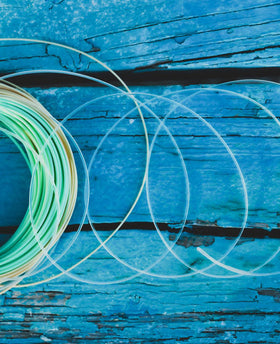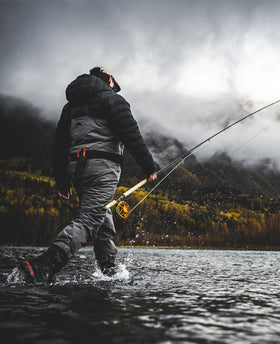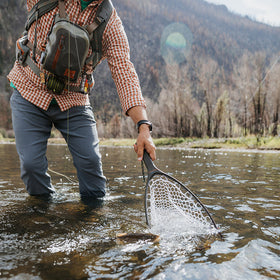
Tails from the Road: Another Pyramid Trip
Intro:
Another Pyramid lake blog? It looks like more than one of the guys here at GFS couldn't wait to kickstart their stillwater season! In order to not make you read the same blog twice I’m going to focus a little more on the logistics while still sharing my experience which will hopefully take out some guesswork for any readers looking to make the journey out to the salty pond.
During my spring break, two friends and I ventured out to Pyramid Lake to try our luck at catching some Lahontan Cutthroat trout. While I am a fairly seasoned stillwater angler here in Colorado, particularly when it comes to cutthroat, I was a little intimidated fishing a lake the size of Pyramid for the large trout that dwell below its surface.
Months of preparation helped calm my nerves for the trip. This involved many hours at the vise tying hundreds of flies as well as purchasing some new gear that serves a special purpose when fishing Pyramid. Finally, on March 15th, all the preparation was finished, and we started our journey west.

The Fishery:
Pyramid Lake is a large alkaline lake located in northwestern Nevada. Surrounded by a mountonus desert biome it is one of the most visually attractive and unique places to fish in the world. It is the thirty-second largest lake in the United States, sitting at an area of 183 square miles and a depth of 350 feet. It is where the famous Truckee River comes to an end. Since there is only an inlet to the lake, all water that leaves is via evaporation. This means that the lake's salt content is slowly increasing and will eventually eradicate all life from the lake.
Pyramid Lake is a remnant body of water from the inland sea Lake Lahontan, which existed at its largest state about 12,700 years ago. Lake Lahontan had a surface area of over 8,500 square miles and spanned over northwestern Nevada, with parts of it bleeding into California and southern Oregon. The ancient lake was broken up by many islands; however, its largest component was located at modern-day Pyramid Lake. Pyramid Lake and Walker Lake are the only two remnants of Lake Lahontan left and are about a two-hour drive apart.
In order to not be redundant for the readers, I will only briefly go over the history of the Lahontan Cutthroat. If you want to hear a more detailed version, go read Xavier’s blog about his time at Pyramid! Long story short, there are two strains of Lahontan Cutthroat in Pyramid Lake. The Summit Lake strain, which has a more torpedo-shaped body and often displays bright red colors. The Summit stain reaches weights of up to 15 lbs. The other strain is the Pilot Peak strain and is characterized by a large bucket head, a more chrome-colored flank, and a larger average size. They have been known to get up to 40 lbs and are also one of the only salmonids to have two rows of teeth, like a shark. The Pilot Peak strain was thought to be extinct but was found in Utah and reintroduced in the mid-2000s. The reintroduction of the Pilot Peak strain has made Pyramid Lake one of the most unique fisheries in the world and an increasingly popular destination for anglers.

Travel:
From Colorado, there are two viable options to travel to Pyramid Lake. Each has its respective benefits and drawbacks.
First is flying into Reno. The main advantage of this travel method is its efficiency. A flight from Denver to Reno is about two and a half hours, which then leaves you with a forty-minute drive to the lake, bringing total travel time without stops to three hours and ten minutes. If you’re a gear nerd like myself, flying can also help you streamline the amount of stuff you bring which can help you focus on the experience and be confident that you are adequately prepared. Bringing your vise on a plane is possible if needed. I use the Fishpond Tailwater Fly Tying Kit when I travel, which holds a vise, tools, and materials nicely.
Driving is the other alternative, which is what I opted for this time. Driving significantly increases your travel time to fifteen hours and some change without stops. This didn’t bother us much as we were able to split the cost of gas and the driving between three people. Driving allowed us to see a good portion of the western United States with destinations such as the Great Salt Lake and Bonneville Salt Flats in Utah. One benefit of driving was having my truck, which is more off-road capable than a rental car. This allowed us to drive to some fishing spots that the average rental car may have trouble getting to. Having a large vehicle with a camper built into the back also meant that we spent far less on lodging than we would have if we had flown. Another benefit of driving was being able to bring my vise and tying materials, which proved to be helpful due to us learning what flies the fish were keying in on as we fished and talked to other anglers.
I enjoyed driving because it offered new scenery for me, and I am accustomed to driving long distances to explore new fishing spots, so this was nothing new. Going for five days with multiple people in one larger vehicle also made driving the best option for our group. In March, temperatures are slightly cold but perfectly adequate for camping, which makes getting to the lake early in the morning super easy. Plus, who doesn't love some car camping while Colorado is still getting snowed on? I will say that if I go back for a shorter period of time or by myself, flying into Reno will definitely be my first choice.

Techniques:
When fly fishing from the shore, Lahontans are typically targeted using two methods. These methods are both effective and are subjective to the area of the lake that you are fishing and the current behavior of the fish. Keep in mind that the fishing regulations allow you to fish a maximum of two flies at a time.
Nymphing:
Firstly, fishing flies under an indicator, also known as nymphing. I spent a lot of my time “bobber watching” while at Pyramid. Fishing under an indicator is the most popular method to target the trout in the lake because it is easy to control the distance from the shore of your rig as well as the depth that each fly is at. Moreover, nymphing allows you to keep flies in the water for long periods of time, which can increase your chances of intercepting hungry, cruising cutthroat. Choppy waves on the lake are ideal when nymphing because as the indicator rises and falls with the waves the flies under the water have more action.
The majority of the lake has a shelf that can be anywhere from 10 - 100 feet away from the shoreline. While the fish push close to shore at certain times of the year, more often than not, feeding trout can be found swimming along the shelf looking for food. Nymphing allows anglers to fish both flies at different depths along the shelf whether they are fishing from a ladder off the beach or off the limestone rock features along the shore.
Stripping Streamers:
Stripping streamers can also be an effective method to target Lahontans. Many frequent visitors of Pyramid Lake have caught their biggest fish stripping. This is as straightforward as it sounds. I found success when using a full sink fly line and casting the flies over or along the drop-off. I then let them sink until they are on the bottom (time changes depending on your fly line, but I found that overestimating the sink time was helpful) and then retrieving them at varying speeds. Make sure you don't preemptively take the flies out of the water because some fish will eat them right at your feet! Stripping can be difficult from the rocks and was more effective from a ladder in my experience. I preferred fishing a sinking fly about two feet in front of a floating fly.

My Experience:
We fished the first couple of days in a bay where a semi-rocky area meets a beach, allowing us to gauge where the fish were and how they were behaving. After two days of fishing, we had better luck off the rocks using an indicator rig in the 8-12 ft depth range. We decided to move south to an area with larger rocks and a more defined drop-off. Immediately upon arrival, we were able to see groups of 2-10 fish cruising within 20 feet of the shore. Once we had our depth and flies figured out, we noticed that most of the fish we were catching were of the summit strain. The only time we would hook into a pilot peak was when the rig was about 40 feet past the drop-off. This was most likely the summits engaging in pre-spawn activity close to shore, while the pilots behaved in a more typical manner further out.

Gear:
Rods:
The unique conditions and fly fishing style at Pyramid Lake have popularized the use of switch rods. Switch rods are essentially lightweight spey rods in regards to the taper of the rod blank. Similar to spey rods, casting them is often done using a two-handed roll cast; however, using a traditional overhead cast is also possible. Switch rods can be helpful for casting long distances in the high winds frequently encountered at Pyramid Lake. I personally used an 11ft 5wt switch rod for my nymphing which performed well but many anglers prefer a 6wt or 7wt in windy conditions. A good budget-friendly switch rod is the Redington Dually and if you are looking to get the best of the best I would consider the Sage Sonic Switch.
For my stripping setup, I used a 9ft 8wt which allowed far casts as well as power when fighting larger fish. Some anglers have also utilized switch rods for stripping flies. You’ll need an 11ft 7wt at minimum to do this as the sinking line and larger flies require more power to adequately cast.
Keep in mind that the weight of switch rods is not the same as generic fly rods. A good rule of thumb is to add two line weights to the weight of the switch rod so, a 5wt switch is closer to a 7wt rod.

Reels:
I used the newly re-designed Lamson Liquid S in size 7+ for both of my rods. The two aspects of a reel that I found necessary were a good drag and a decently large arbor. A good sealed drag protects your reel from the salty water and helps you fight large fish that tend to go on long runs into your backing. A large arbor helps pick up line efficiently as you often put fish on the reel.
Fly Lines:
For nymphing using a switch rod, the Rio Switch Chucker or the Scientific Anglers Integrated Switch fly line is the only way to go. I used the Switch Chucker, which is a floating line with a shooting head. The 25ft shooting head is heavily weighted and is what enables long roll casts.
The fastest sinking line that does not overload your rod’s grain window is what I found to be most effective when stripping. A full sink line allowed me to have a better connection to my flies where a sink tip line tended to bow in the current created by the wind which prevented me from detecting strikes.
Terminal Tackle:
Since the methods used to fish Pyramid Lake are unique when compared to most applications of fly fishing, it can be advantageous to build your own leader. My leader recipe for Pyramid was as follows: 2.5ft of 25 lb green Amnesia monofilament, connected to the fly line using a perfection loop. Then I tied the end of the mono section to a micro swivel. From the other end of the swivel, I would tie a 6-7 ft section of 0x fluorocarbon down to the first fly. From the hook shank of the first fly, I would tie 2 - 2.5 ft of 0x or 1x to my bottom fly.
You can also tie a micro swivel to the end of the first fluorocarbon section and fish one fly on a 6-8 inch tag and the other on a 2 - 2.5 ft tag. Having most of the leader aside from the Amnesia butt section be fluorocarbon is important because it sinks faster and stays in a straighter line when compared to a traditional tapered leader. Finally, a medium or large Oros indicator on the 25 lb butt section of the leader.
Flies:
When nymphing, chironomids are a good choice for hooking into some fish. During the spring and fall months when the water temperature is higher, chironomids will hatch and become a main food source for the Lahontans. While I was at Pyramid, the hatch was slow and the fish were not keyed in on chironomids but I still managed to catch fish on them. We found the most success while using wine, black and olive colored chironomids. Sizes 12 - 14 worked best but if the hatch is slow don't be afraid to try a size 16.
We found that changing water temperatures prevented the chironomids from hatching at a high rate and that fish were keying in on other food items. The balanced leech was the main ticket for us and seemingly everyone else having success around us. My most effective color was a dark olive with a gold bead however a bruised black with an orange bead also worked well. Other flies similar to a balanced leech such as a balanced bait fish can also work well and are worth a shot.
For stripping flies, a black or white wooly bugger I picked up from the shop worked great. Behind that I liked to fish beetles. The Pyramid Lake Beetle and the Cyclops Beetle are tied using 3mm foam so when stripped using a sinking line, the beetle will shoot downwards and then float back up during the pause in your strip, offering a unique action to the fly. The beetles can represent the aquatic beetles that live in the lake as well as bait fish and are typically tied in white/chartreuse or black/red colorways. I liked to always have a dark and light fly on.

Reflection:
Hopefully, this has helped alleviate some of the uncertainty that accompanies any fishing trip. While there are many things you can do to increase your chances of success at Pyramid, I found that the biggest factor was fishing hard and having fun. No one likes the person who is simply trying to out-fish everyone else. Landing a fish at Pyramid is a group accomplishment, and you should be excited to see anyone hook up. While flies do matter, your best chance of hooking up is simply to have flies in the zone where they are most likely to intercept a hungry trout for the longest time possible. This means that when the fishing is slow, you need to fish hard. For me, that meant getting up before sunrise and fishing all day until sunset, when I couldn't see my indicator anymore.
Pyramid is a special place that holds cultural significance in the Reno area as well as in the fly fishing community. Anglers make the pilgrimage to the lake not only to chase monster trout but also to reunite with old friends and make new ones. I have never been somewhere where people shout out what fly they just caught a fish on across the bay or roll down their window as they drive by to wish you good luck while you rig your rods. It's these aspects of Pyramid that make even the slowest days a pleasant experience. People flock to Pyramid for the fish but stay for the friends and memories.

I hope you enjoyed our third edition of Tails from the Road and if anyone has questions or comments please feel free to call the shop at 303-330-1292. Also, if you’re gearing up to go to Pyramid yourself, stop into the shop and we’d be happy to help you out with our top flies, rods, reels, and terminal tackle. Tight lines!






Leave a comment